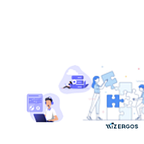First: Software Products
Most users are already familiar with Software Products. We use them everyday, and we know them as Apps that we love: Google Mail App, Sales Force App, Amazon App etc. These products have a fixed value to offer to the you, the end-user, and while end-users can customize their products to some degree, it is usually limited to a few settings that you can make.
Software Products or Apps can themselves can be categorized into multiple ways. One way is to categorize Software Products is on the Device they run. For example, a software product be a mobile App, or a Desktop. Another way is by the user type: B2B or B2C, depending on the type of user that is using the App. Still another way to categorize Apps are on the kind of Interface they may have: Graphical User Interface like Amazon App, Conversational User Interface like FaceBook Messenger, Voice Interface like Alexa etc.
So what is a Software Platform?
Simply put, a software platform is a special software that is used to create other software products. Companies invest in platforms in the hope that future products can be developed faster and cheaper, than if they built them stand-alone.
Because of its nature, the Software Platform is not always visible to the end-user. For example, Technology Platforms are meant for the technical community to use a Platform to build other Software Products. For example, Lightning is the Platform that helped build SalesForce App, and the thousands of App listed on SalesForce AppExchange. Apple iOS, Google Android are other Platforms that are used by Developers to build other Apps available on the iStore or the Play Store on your mobile. Or for example Amazon Web Services (AWS) that is used to host millions of apps that are used to not just run Amazon app, but also to run other Apps. On the other hand, a Two-Sided-Marketplace Platform like Uber is very familiar to end-users.
Depending on the type of Business & Technology models, there many different kinds of Platforms. The first Platform category is a pure Technology, the rest 4 Platforms involve both Technology & Business Models.
- Pure Technology Platforms: These type of Platforms provide common building blocks or services that can be reused in a large number of software products. 3rd party developers use these building blocks and services to create different software products for their end-users. One thing to note is that the Technology Platform does not play a role in bringing users from one Software Product to another Software Product, and the third-party developers “owns” the end users. Amazon Web Services, and Twilio are examples of Technology Platforms.
- Store Platforms: These type of Platforms provide additional services beyond what the Technology Platform provides. Store Platforms provide the crucial to enable users to discover, recommend, and monetisation of Software Products built on these Platforms. So the Store Platform “owns” the end-user and not the third-party Developers who built such Software Products. Apple iOS, Google Play Store or SalesForce AppExchange are typical Store Platforms, where a user needs to login and share data with Apple, Google or SalesForce Platforms respectively. The actual App Developer may not always get to know the same level of end-user data as that of the Platform.
- Data Platforms: This type of Platforms provide end-user Services directly and “owns’’ the end-users. End-Users may not be able to Interact with other end-users. The data/content generated by end-users is then used for other Developers/Agencies to create ancillary Services like Advertisements, Anonymized Statistics etc. Examples include Google Search, Google Maps etc.
- Content Marketplace Platforms: This type of Platform enables end-users to share content for other end-users. The content generated by end-users is then used for other Developers/Agencies to create other Services like Advertisements, Anonymized Statistics etc. Examples include Facebook, Instagram, Youtube, TripAdvisor etc.
- Two-sided Marketplace Platforms: This type of Platforms have two sets of end users, and “owns” both the sets of the users, and provides Services to both the end user sets. Typically one set is a demand-side users (buyers) and the other is a supply-side users (sellers). Examples include Amazon Marketplace, eBay, AirBnb, Uber, etc. Enact is another example of a two-sided platform in the Distributed Energy space, with Engineers on one hand, and end Customers on the other.
As can be seen there is a large diversity of Platforms based on business models. End-Users or Enterprises use one or more of these Platforms to bring Flexibility and Agility to their daily tasks or business processes.
A special mention about Technology Platforms. These can be further subdivided into several segments. For example, Wizergos is a Application Development Platform within the broader Technology Platform space. Wizergos enables Developers to build Enterprise Software Products with flexibility and with agility using Zero or Low Code. In my next write-up, I will discuss how Technology Platforms help build Solutions.
